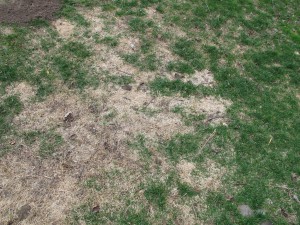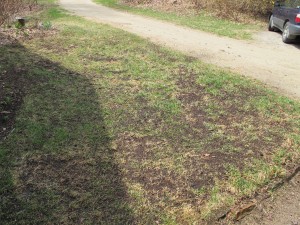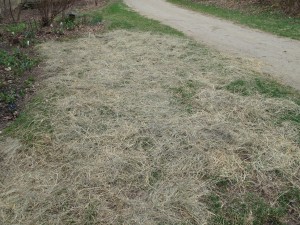Spring Lawn Care
It’s time for a little lawn care. I’m not obsessive about my lawn, but I like a nice green swath between the flower beds that is suitable for badminton, croquet or general lounging. It need not be Kentucky bluegrass, and certainly should have some dandelions, those cheerful harbingers of warm days and blue skies. For me, if it’s green and I can mow it, it’s a lawn.
Right now my lawn is not all green. Not by a long stretch. My household includes 3 dogs, and they have killed a fair amount of grass right outside the front door. And then there are the moles out back that have been excavating their own Big Dig much of the winter.
Dead spots and thin spots need to be seeded, and the ground is warm enough now to do that. I use a “conservation mix” because it is full of good tough varieties that can take a beating more than one that is largely Kentucky bluegrass. And diversity is good for minimizing disease problems.
For large dead spots I take a short-tined garden rake and rake the dead grass out, roots and all. Then I spread half an inch of good compost over the area and scratch it into the top inch or so with a rake. I broadcast a fairly dense sprinkle of seed (by hand), then use a lawn rake to mix the seed into the top quarter inch. I do this by flipping over the rake and dragging the long tines over the soil – upside down. That lightly buries the seed, though there is always still seed visible. Grass seed doesn’t need much soil cover, if any. Lastly, I spread a little mulch hay or straw over the top – just enough to shade the soil and keep it from drying out.
In some areas the grass is growing but is sparse, or contains some dead grass. There I briskly rake the lawn using a bamboo or metal awn rake to remove the dead grass as much as possible. Next I spread some compost with a shovel and even it out with my rake. Then I “overseed” the lawn with seed, just sprinkling it by hand (though I suppose you could do it with a seed spreader). I don’t spread straw on the overseeded places, as there is enough existing grass to provide shade. Generally the soil stays damp at this time of year, too.
You may have noticed that I did not mention adding fertilizer to the lawn. My soil is pretty good because I don’t collect my grass clippings when I cut the lawn, and I do not add any herbicides or insecticides to kill weeds or bugs. Chemicals of any sort, even chemical fertilizer, inhibit the growth of beneficial bacteria and fungi in the soil. My “lazy” way of dealing with the lawn helps me to have biologically active soil, one rich with microorganisms that break down grass clippings, enriching the soil. Earthworms are a big help, too, aerating the soil and fertilizing the soil with their castings.
If you feel you must add fertilizer to the soil, choose an organic one. Instead of chemical salts that can harm beneficial microorganisms, an organic fertilizer has naturally occurring ingredients like ground oyster shells and peanut hulls, chicken manure and seaweed. Chemical fertilizers can dissolve and disappear in a week of rain, but the ingredients of organic fertilizers won’t.
Want to minimize crab grass? Corn gluten contains a protein that reduces germination of weed and crabgrass seeds in the lawn. It is usually sold at feed-and-grain stores or garden centers in 50-pound bags. You can’t apply it when you seed your lawn, as it would affect good grass seeds, too. But it’s not a miracle. It will reduce germination, but it doesn’t kill weeds or their seeds.
I’m told that corn gluten works best when applied 3 years in a row. And one last benefit: it also acts as an organic fertilizer that contains about 10% nitrogen by weight, breaking down and releasing the goodness slowly. This is the time of year to spread corn gluten – though I must admit, I never have.
About those moles: they seem to do most of their excavation in the fall and winter, leaving piles of nice soil on the lawn. I just rake that soil onto a wide shovel, collect it in my wheelbarrow, and then add it to raise beds elsewhere, or to fill in depressions.
Moles can be repelled with castor-oil based solutions. I used to make my own, but all castor oil at the pharmacy seems to be the new, better, more modern “good tasting” kind. But garden centers still sell mole repellents made with castor oil, and though I haven’t tried them, they should work just fine.
And what about moss? I ignore it. It generally grows in shady areas that are acidic. If you don’t like it, rake it out and plant seed designated for shady areas. But first add some limestone and compost to sweeten the soil and improve the soil. On-line I read about a moss killer that promises “one application will kill moss for a year”. That makes me shudder when I think about my dogs walking on that soil, were I to apply it – which I will not!
So go out and enjoy the sun. And remember that setting the blades of your lawnmower to 3 inches will help your grass have more energy and will help to shade out crabgrass and weeds.
Henry’s Web site is www.Gardening-guy.com. See past columns there or search for answers to gardening questions.





